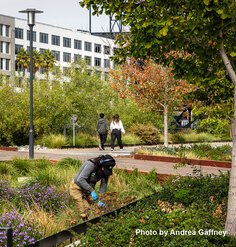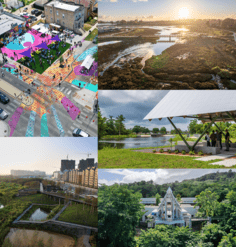From the Field: Good Ol’ Sun-Fearing People and the Social Life of Cool Urban Spaces
By Justin Earl, MLA Candidate; Dylan Stewart, MLA; Ryan Brown, MLA Candidate; Taner R. Ozdil, PhD, Associate Professor; and James Richards, Associate Professor, Program in Landscape Architecture, School of Architecture, University of Texas at Arlington
You could say that the people in Texas welcome the summer with a healthy dose of dread. During the summer here, the sun is not your friend. Urbanites avoid outdoor activity during the hottest parts of the day, and every square foot of shade is a precious commodity.
Aversion to the summer sun and heat is one of the biggest hindrances to Texans buying into the possibility of successful outdoor urban spaces. Naysayers will tell you no one here wants to be outside in the summer unless they have to be. However, in recent years a few landscape architectural projects in Fort Worth and Dallas have taken direct aim at the challenge and have created public landscapes very sensitive to people’s needs for a cooling atmosphere during the hottest months.
This summer, our Case Study Investigation (CSI) research team, in partnership with two design firms (Michael Vergason Landscape Architects and SmithGroupJJR), is working to measure the benefits of two such projects. The team has been happy to find that there are a lot of undeterred folks out at the sites just having fun. While investigating the strong economic and environmental performance of the sites, the team is most keen on exploring social life by surveying users’ opinions and spending several days mapping and recording on each site to determine what is attracting and retaining the people who utilize these spaces.
Sundance Square Plaza in Fort Worth was designed by Michael Vergason Landscape Architects and is the centerpiece of a downtown revitalization that has been going strong for the past 30 years. 32-foot-high sculptural umbrellas and a bosque of native Cedar Elms provide comfortable shade for sitting and people-watching, while a programmable play fountain and a wave fountain are magnets for energetic children. Alfresco dining for popular cafés on two sides of the plaza as well as a stage for performances draws plenty of visitors to contribute to the ‘sidewalk ballet.’ During our site observation days, we are closely tracking people’s activities on the plaza to understand where visitors seem to congregate and feel comfortable while taking area temperature readings to determine how the microclimates of the plaza differ from other areas downtown.
AT&T Performing Arts Center: Elaine and Charles Sammons Park, designed by SmithGroupJJR, is the central outdoor open space of the Dallas Arts District. It features the Winspear Opera House’s large protruding shade structure, which provides comfortable dappled shade near a water skin reflecting pool and swaying drifts of native and adapted ornamental grasses and wildflowers. While digital models for shadow studies are in the works, our team is conducting test runs of our observation strategies for the site. So far the most common activity for park users has been taking photographs of the park and the surrounding architecture, with length of stay on the site averaging 14.5 minutes. Of the people who stopped and took advantage of the plentiful seating options in the park, 100% sat in the shaded area.
Our team is working daily to research and document the environmental and economic benefits of the two sites while accumulating responses from our online surveys. We still have many hours of site observation to conduct over the next few weeks and look forward to discovering how both plazas respond to Texas’ summer climate and provide people with enjoyable outdoor environments.
Research Fellows Taner R. Ozdil and James Richards and student Research Assistants Justin Earl, Dylan Stewart, and Ryan Brown are participating in LAF’s 2014 Case Study Investigation (CSI) program and working to document the performance of two exemplary landscape projects in hot, sunny Dallas and Fort Worth, Texas. Any opinions expressed in this article belong solely to the author. Their inclusion in this article does not reflect endorsement by LAF.










